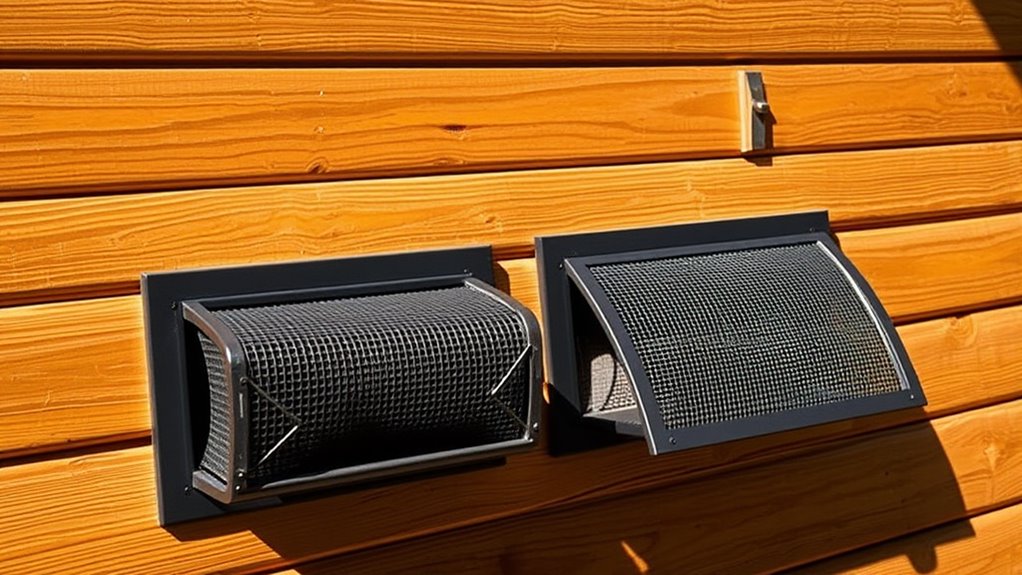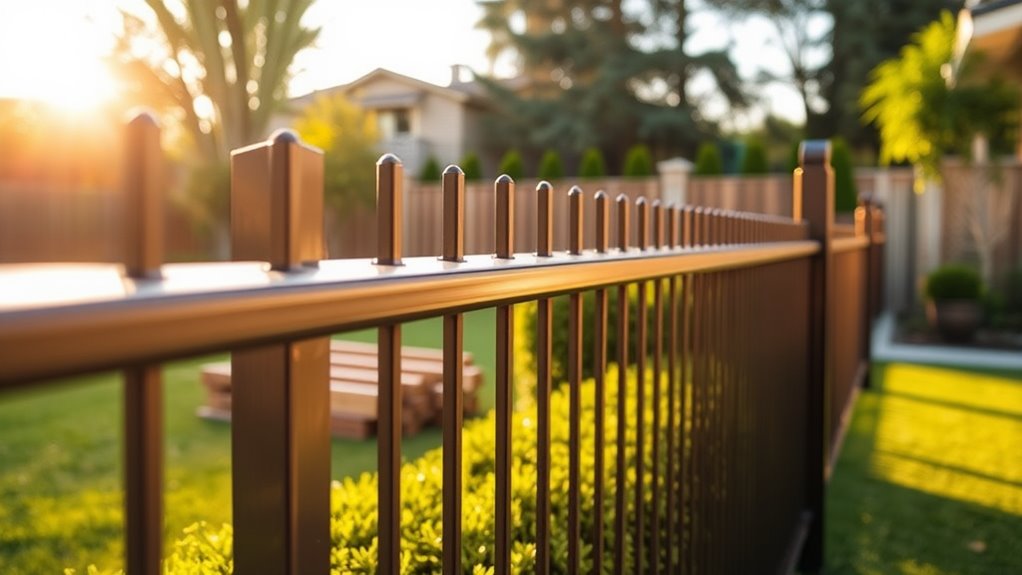To fireproof your home from wildfires, create a defensible space by maintaining a 30-foot greenbelt and removing flammable materials. Use fire-resistant roofing and siding like metal, tile, or stucco, and install ember-resistant vents to block flying sparks. Keep gutters and roofs clear of debris, and opt for tempered glass windows. Replace wooden fences with noncombustible alternatives, and guarantee emergency access is unobstructed. Implementing these strategies boosts your home’s resilience—and there’s more to explore on enhancing your fireproofing measures.
Key Takeaways
- Create a 30-foot defensible space by removing flammable materials and using fire-resistant landscaping.
- Use fire-resistant materials like metal roofing, stucco siding, and tempered glass windows.
- Install ember-resistant vents and screens to prevent embers from entering your home.
- Maintain clean gutters, roofs, and remove dead vegetation to reduce ignition risks.
- Ensure clear emergency access with wide roads, visible signs, and easily operable gates.
Fireproof Your Home From Wildfires – Defensible Space
To reduce wildfire risks, you should establish a defensible space around your home, starting with a 30-foot irrigated greenbelt. In the immediate zone (0-5 feet), focus on home hardening by removing flammable materials like wood piles and dried vegetation. Clean roofs and gutters regularly to eliminate debris that could ignite. Repair loose shingles and guarantee vents are covered with fine mesh to block embers. In the intermediate zone (5-30 feet), create fuel breaks by mowing lawns to four inches, pruning trees to remove ladder fuels, and spacing shrubs to reduce fire risk. In the extended zone (30-100 feet), thin dense vegetation, dispose of heavy ground litter, and maintain proper canopy spacing to prevent fire spread. Regularly inspect and maintain these zones to keep them effective. Consult local forestry professionals for tailored advice on vegetation management and fire-resilient landscaping practices to enhance your property’s defense.
Use Fire-Resistant Materials for Roofing and Siding
When wildfires threaten, your home’s exterior materials can make a critical difference, so prioritize fire-resistant options for roofing and siding. For roofing materials, choose metal, tile, or fiberglass over traditional asphalt shingles, as they withstand high temperatures and reduce ignition risks from embers. These non-combustible materials provide superior protection during extreme heat exposure. For siding materials, opt for stucco, brick, or fiber-cement, which offer enhanced resistance to direct flames and radiant heat compared to untreated wood or vinyl. Dual- or multi-pane tempered glass windows also improve fire resistance, as they’re less likely to shatter under extreme conditions, preventing ember intrusion. Regularly inspect and maintain both roofing and siding to guarantee they remain intact, as even minor damage can increase ignition risks. Always verify that your materials meet local fire safety codes to maximize your home’s overall fire resistance and minimize wildfire-related damage.
Install Ember-Resistant Vents and Screens

Ember-resistant vents and screens play an essential role in preventing wildfire damage, as flying embers can easily infiltrate traditional vents and ignite combustible materials inside your home. You should prioritize installing these vents, which feature multiple layers, including stainless steel mesh screening and intumescent materials, to block embers and reduce ignition risks. Retrofits of existing vents with ember-proof mesh are a practical, cost-effective solution that you can often complete yourself using screws and caulk, enhancing your home safety. Regularly inspect and maintain these vents to guarantee they remain free of combustible debris and damage, as blockages can trap heat and increase fire risks. While custom-fitted ember-resistant vents may cost around $7,000, DIY options provide an affordable way to improve fire resistance. Pairing these vents with ember-resistant gutter guards further minimizes the accumulation of combustible debris, bolstering your home’s defense against wildfires.
Maintain Clean Gutters and Roofs
Because gutters and roofs are critical components in defending your home against wildfires, keeping them clean is essential. Regularly maintain gutters by removing leaves, debris, and other flammable materials that can trap heat and ignite during a wildfire. Installing noncombustible gutter covers can prevent debris buildup and reduce fire risk. Inspect roofs for damage, such as loose shingles or tiles, as these vulnerabilities allow embers to penetrate and ignite the roof structure. Repair or replace worn or damaged roofing materials with fire-resistant options to enhance protection. Additionally, remove dead vegetation and flammable materials from the area around roofs and gutters to eliminate potential ignition sources. By consistently cleaning and inspecting these areas, you guarantee they remain effective barriers against embers and flames, greatly reducing your home’s wildfire risk. Prioritize these maintenance tasks to fortify your home’s defenses.
Choose Fire-Resistant Landscaping

Start by creating a defensible space of at least 30 feet around your home, using low-density ground covers and shrubs to minimize ignition risks. Select fire-resistant, native plants that require less water and are naturally less flammable to reduce fire hazards. Maintain proper spacing between vegetation and guarantee plants are well-irrigated to enhance their fire-resistant qualities.
Defensible Space Creation
By strategically designing your landscape with fire-resistant materials and vegetation, you can create a defensible space that greatly reduces wildfire risk to your home. Start by focusing on the immediate zone (0-5 feet), where you’ll remove flammable materials like wood mulch and replace them with non-combustible materials such as gravel or stone. In the intermediate zone (5-30 feet), implement vegetation management practices—mow lawns to four inches, clear debris, and space plants to minimize fire spread. The extended zone (30-100 feet) requires proper tree spacing, ideally 10 feet apart, to prevent canopies from creating a fire path. Incorporate fire-resistant landscaping elements like gravel paths and maintain a well-pruned environment to interrupt potential fire paths and enhance your home’s safety.
Fire-Resistant Plant Selection
In addition to creating defensible space, choosing fire-resistant plants enhances your home’s protection against wildfires. Opt for native plants that are drought-resistant and have low sap content, as these traits reduce flammability and improve fire resilience. Select species with high moisture content, such as succulents, which are less likely to ignite compared to dry, woody vegetation. Incorporate fire-resistant ground covers like gravel or stone paths to interrupt potential fire paths and strengthen defensible space. Maintain proper spacing between trees and shrubs, aiming for at least 10 feet apart, to minimize the risk of fire spreading. Regularly water and maintain these plants to guarantee they remain effective wildfire barriers. By strategically selecting and caring for fire-resistant landscaping, you’ll considerably bolster your home’s defense against fire threats.
Protect Windows and Doors With Tempered Glass
Install tempered glass windows to enhance their resistance to heat and impact during wildfires. Use dual- or multi-pane tempered glass to reduce radiant heat transfer and improve ember protection. Pair them with fire-resistant screens to further shield your home from airborne embers.
Install Tempered Glass
Tempered glass is a critical upgrade to strengthen windows and doors against wildfire threats. It offers superior fire resistance, withstanding higher temperatures and reducing the risk of shattering compared to standard glass. Its inherent strength—four to five times greater than regular glass—provides a reliable barrier against radiant heat and flying embers. For enhanced insulation and damage prevention, choose dual-pane tempered glass, which further mitigates heat intrusion. Regular inspections guarantee your tempered glass remains intact and effective, as cracks or damage can compromise its performance. Integrating tempered glass with other fire-resistant building materials forms a thorough strategy for wildfire resilience. By prioritizing this upgrade, you’ll notably improve your home’s ability to withstand extreme conditions, safeguarding both structure and occupants.
Use Multi-Pane Windows
Multi-pane windows offer an effective fire-resistant upgrade for homes in wildfire-prone areas, building on the protective benefits of tempered glass. With improved fire resistance, dual- or triple-pane designs reduce heat exposure and block radiant heat from penetrating interiors. Incorporating tempered glass enhances their ability to withstand high temperatures and prevent breakage from flying embeds. These fireproofing measures also improve energy efficiency by minimizing heat transfer, providing year-round benefits. Regularly inspect and maintain your windows to guarantee they remain effective; compromised windows can increase vulnerability. While window screens provide additional protection, focusing on multi-pane windows guarantees a strong first line of defense. Below is a comparison of key features:
| Feature | Single-Pane | Multi-Pane |
|---|---|---|
| Fire Resistance | Low | High |
| Heat Exposure | High | Reduced |
| Energy Efficiency | Low | Improved |
| Maintenance | Frequent | Moderate |
Add Fire-Resistant Screens
Fire-resistant screens act as a critical barrier, preventing embers from infiltrating your home during a wildfire. These screens, typically made of 1/8-inch mesh screening, block embers from entering through windows and doors, considerably reducing ignition risks. When paired with tempered glass or multi-pane windows, they enhance your home’s fireproofing and insulation. Here’s how to integrate them effectively into your hardening strategies:
- Install Screens on All Openings – Cover windows, vents, and doors with fire-resistant mesh screening to create a thorough barrier.
- Combine With Tempered Glass – Use tempered glass for windows, as it withstands high temperatures and complements the screens’ protection.
- Regular Maintenance – Inspect and repair screens and seals annually to ascertain they remain intact and effective against embers.
This layered approach fortifies your home’s defense against wildfires.
Replace Wooden Fences With Noncombustible Alternatives

One critical step in fireproofing your home involves replacing wooden fences with noncombustible alternatives like metal or masonry. Wooden fences are highly flammable and can act as a direct pathway for embers or flames to reach your home during wildfires. By installing fire-resistant fences, you create a barrier that helps protect your property. These noncombustible materials not only resist ignition but also reduce the risk of fire spread, contributing to your home hardening efforts. Regularly inspect and maintain these fences to verify they don’t accumulate flammable debris, which could compromise their effectiveness. This simple upgrade enhances your defensible space, making your property more resilient to wildfires.
| Material | Fire Resistance | Maintenance Required |
|---|---|---|
| Metal Fencing | High | Low |
| Masonry Walls | Very High | Moderate |
| Wooden Fencing | Low | High |
Ensure Proper Access for Emergency Responders
Accessibility is essential when preparing your property for emergency responders during wildfires. Confirming that your property is easily reachable for firefighting equipment and personnel can greatly improve emergency response times. Here’s what you need to focus on:
- Clear Access Roads: Maintain access lanes that are wide enough (at least 12 feet) and sturdy enough to support fire vehicles. Regularly trim vegetation and remove obstacles to keep these roads clear for unimpeded passage.
- Visible Identification: Install highly visible street signs with unique names and house numbers. This helps emergency responders locate your property quickly during a crisis.
- Turnaround Areas: Designate turnaround areas on dead-end roads to allow fire vehicles to maneuver safely. Position gates to open inward and confirm they’re easily operable by emergency personnel.
Conclusion
You can greatly reduce wildfire risks by implementing these measures. In fact, homes with defensible space are 2.4 times more likely to survive wildfires. Prioritize fire-resistant materials, ember-resistant vents, and noncombustible landscaping to protect your property. Regularly maintain gutters, roofs, and access points to guarantee safety. These steps not only safeguard your home but also aid emergency responders. Proactive fireproofing is essential for resilience in wildfire-prone areas.




